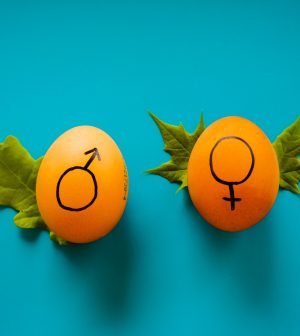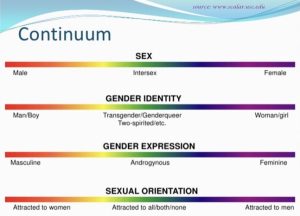- Finding Unshakable Power in a World That Wants to Pull Us ApartPosted 5 months ago
- What could a Donald Trump presidency mean for abortion rights?Posted 5 months ago
- Financial Empowerment: The Game-Changer for Women in Relationships and BeyondPosted 6 months ago
- Mental Health and Wellbeing Tips During and After PregnancyPosted 6 months ago
- Fall Renewal: Step outside your Comfort Zone & Experience Vibrant ChangePosted 7 months ago
- Women Entrepreneurs Need Support SystemsPosted 7 months ago
Gender Living...challenging assumptions about identity

By Lisa Carberry
Is it a boy or is it a girl? This is one of the first questions that any new parent is asked upon the birth of their child. From this point onwards, this new being will receive messages that train, instruct, shape and give form to a mental image that carves out a gender identity based on their sex at birth.
With this constructed identity comes expectations of how they will look, speak, act, what their interests will be, the work they will do, how they will be regarded by others around them and what their place in the world will be. This human being will be raised to follow other people’s voices, while their own voice is muted. The messaging they will receive from society says that they will only be as good as other people see them.
Whether we care to admit it or not, all of us have become married to an image of self and others that has been culturally constructed. We have become married to a patriarchal hierarchy that impinges on every aspect of culture and society. It is so internalised that we have been tricked into believing that its voice is our voice.
We have been told that knowledge is power. But what if we have been given the wrong information? What if everything that we have been led to believe about who we are and who others are is actually a falsehood that has been deceiving us? And what if the deception is causing harm?
Compared to the general population LGBTQIA+ people are more likely to attempt suicide and experience significantly poorer mental health outcomes. Within Australia, according to survey results published in May 2021 by LGBTIQ+ Health:
- LGBTI young people aged 16 to 27 are five times more likely to attempt suicide.
- Transgender people aged between 14 and 25 are fifteen times more likely to attempt suicide.
- LGBTI people aged 18 or over are over eighteen times more likely to have considered attempting suicide in the previous 12 months.
- Transgender people aged 18 or over are 6.5 times more likely to have engaged in self-harming behaviours in their lifetime.
- LGBTIQ people are 2.5 times more likely to have been diagnosed or treated for a mental health condition in the past 12 months.
- LGBTI people are 6 times more likely to experience and be diagnosed with depression.
- Transgender and gender diverse people 18 and over are 5.5 times more likely to experience and be diagnosed with depression.
These statistics are shocking to say the least and provides direct evidence that the messaging around identity is causing harm.
 A way to begin reducing the harm of the inherent false information that has become part of culture and society is to get educated, starting with understanding the gender continuum. The gender spectrum or continuum consists of four levels.
A way to begin reducing the harm of the inherent false information that has become part of culture and society is to get educated, starting with understanding the gender continuum. The gender spectrum or continuum consists of four levels.
The first level on this continuum is sex. This relates to the terms male, female or intersex, that a doctor or midwife uses to describe a child at birth based on their external anatomy. It is what is referred to as the sex assigned at birth.
Next on the continuum is gender identity, which relates to how a person perceives themselves and what they call themselves. This may or may not be the same as their sex assigned at birth. A person may have a sense of themselves that they are male, female, a blend of both or neither male nor female. The individual will often use pronouns such as she/hers, he/his, or they/them/their according to their gender identity. Others will choose not to use pronouns, instead using their name alone to identify themselves.
The third level is gender expression, which is how a person externally expresses their gender identity through clothing, behaviour, and body characteristics etc.. These expressions may or may not conform to socially and culturally defined behaviours and characteristics typically associated with being masculine or feminine.
Sexual orientation is the fourth element of the gender continuum and is independent of a person’s gender identity. Sexual orientation refers to an inbuilt emotional, romantic or sexual attraction to other people.
Getting clear about and becoming familiar with the gender continuum is an important first step towards reducing the harm that has been caused by following and listening to the voice of patriarchal structures within our global society.
Not making assumptions about an individuals gender identity based on how they look is a second step. Respecting a persons name, gender identity and pronoun is another step. Remembering that it’s not up to us to decide another person’s identity is also a fundamental step.
A further step that is absolutely imperative is taking a deep dive into ourselves, examining, exploring and questioning our beliefs and where they have come from. Not only that, how these beliefs have shaped our own identity and expression of that in the relationship we have with ourselves and in our relationships with others.
Ask yourself ‘Why does it matter to me if someone doesn’t identify as a boy or a girl?’ ‘Why does it matter to me if someone identifies with a gender that isn’t the same as their assigned sex at birth?’ ‘What assumptions do I make about a person based on how they look?’ ‘What language do I use to describe another based upon my assumptions?’ The answers that come will provide you with insights into the beliefs you have adopted about sex, gender identity, gender expression and sexual orientation.
Perhaps, after this inward reflection you will be prompted to seek a divorce. A divorce from the voice of patriarchy and patriarchal structures. A divorce from the false messaging. A divorce from the mental image you have had constructed for you regarding your own identity and that of others.
What is the settlement you get from this divorce? You find your voice. Other people can find their voice. And you carve out a new identity for yourself with the power of knowledge based in truth…the truth of who you really are which allows you to see and embrace another for who they are!
********
 Lisa Carberry is an inclusion and diversity expert specializing in lgbtiqa+ visibility and empowerment. She is also a professional intuitive, author, actor, social justice advocate, and public speaker on a variety of topics. For Lisa, her work is an exciting adventure through which she enjoys supporting people on their journey toward a deeper sense of self and witnessing the creative power this releases.
Lisa Carberry is an inclusion and diversity expert specializing in lgbtiqa+ visibility and empowerment. She is also a professional intuitive, author, actor, social justice advocate, and public speaker on a variety of topics. For Lisa, her work is an exciting adventure through which she enjoys supporting people on their journey toward a deeper sense of self and witnessing the creative power this releases.
Feature Slider Image by Dainis Graveris






